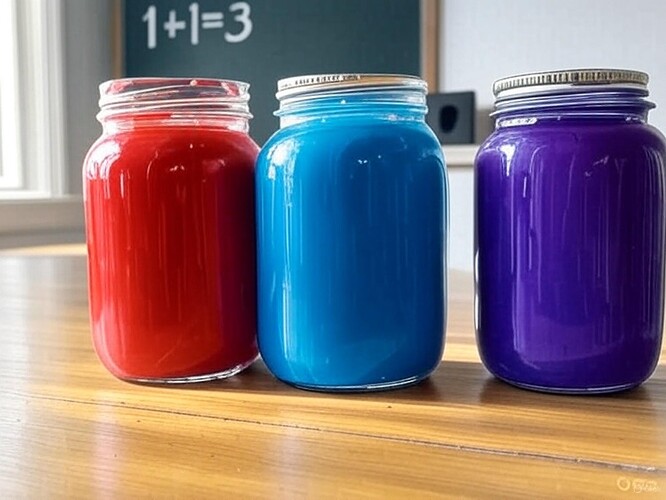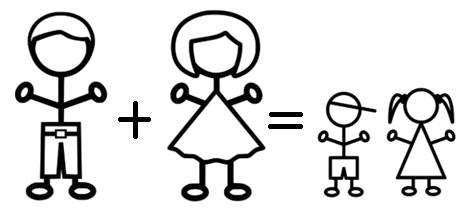Howdy!
It’s been so long since I posted or built anything! I’ve had some major health family events happen and have made it somewhat through the storm.
I’ve been searching for inspiration over the last months, and I’m so fortunate to be part of this makers group and seeing all the creativity!
I’m back at it, going in the garage today to map out my ideas and have been thinking of new concepts, new applications, and how to take the laser and CNC processes to a higher level of making.
Sometimes, having a different perspective makes all the difference.
Cheers!
I made this image with Grok
The image presents an intriguing juxtaposition of an incorrect mathematical equation, “1 + 1 = 3,” with a visual representation that offers a creative twist on its meaning. Let’s dive deeper into this by exploring the interplay between the mathematical inaccuracy and the artistic symbolism of the three paint jars—red, blue, and purple—suggesting a color-mixing narrative.
Mathematical Context and Intentional Discrepancy
At face value, “1 + 1 = 3” is a clear violation of basic arithmetic, where the sum of one unit and another should unequivocally equal two. This deliberate error serves as a provocative hook, inviting viewers to reconsider the equation beyond its literal interpretation. Mathematics is a domain of precision, and deviations from it often signal a metaphor or philosophical statement. Here, the equation might be intended to challenge conventional thinking, suggesting that in certain contexts—particularly those involving creativity or synergy—the outcome can transcend simple addition.
Color Mixing as a Symbolic Framework
The three jars of paint provide a compelling visual clue to reinterpret the equation. In color theory, red and blue are primary colors, and when mixed, they produce purple, a secondary color. This process aligns with the image’s layout: two jars (red and blue), with a third (purple) on the end, positioned as if it’s the result of their combination. This mirrors the equation “1 + 1 = 3,” where the “1 + 1” could represent the red and blue paints, and the “3” could symbolize the emergent purple, a new entity born from their union.
This interpretation transforms the equation into a statement about creative synthesis. In art and science, combining two distinct elements can yield a third that is distinct and valuable, often exceeding the mere sum of its parts. The purple jar, therefore, becomes a tangible representation of this principle, suggesting that the whole (purple) is greater than the individual contributions (red and blue) in a qualitative sense. This idea resonates with concepts like synergy, where collaborative efforts or chemical reactions produce outcomes that defy linear expectations.
Broader Implications and Artistic Metaphor
The “1 + 1 = 3” equation, when viewed through the lens of color mixing, can be seen as a metaphor for innovation and transformation. In fields like design, chemistry, or even human collaboration, the combination of two ideas, skills, or resources can lead to a third outcome that is novel and enriched. For instance:
- In art, mixing pigments creates new hues, expanding the palette.
- In business, two companies merging might create a third entity with greater market impact.
- In nature, the interaction of two elements can produce a compound with unique properties.
The chalkboard setting reinforces an educational or experimental tone, as if the image is a lesson or thought experiment. The use of bright, glossy paint jars adds a sense of vibrancy and possibility, contrasting with the stark blackboard to highlight the emergence of something new.
Reconciling the Equation
While “1 + 1 = 3” remains mathematically false, the image cleverly bends this rule through visual storytelling. If we assign “1” to each primary color (red and blue), their combination doesn’t just yield purple (a third color) but also introduces a new quality—creativity, diversity, or value—that isn’t accounted for in the initial “2.” This aligns with philosophical or poetic expressions where “1 + 1 = 3” symbolizes the added value of unity or interaction, a concept sometimes explored in discussions of teamwork or holistic systems.
Conclusion
The image’s deeper meaning lies in its celebration of creative alchemy. The incorrect equation “1 + 1 = 3” is not a mistake but a deliberate invitation to think beyond arithmetic, using the mixing of red and blue to produce purple as a metaphor. It suggests that in the realm of imagination and collaboration, the result can be a third entity—richer, more complex, and greater than the sum of its parts. This interpretation transforms a mathematical absurdity into a profound statement about the potential of combining diverse elements, making the equation “somewhat true” in a symbolic, artistic sense.

